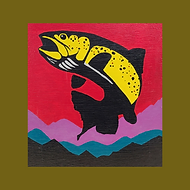Basic Entomology for Fishing in Rocky Mountain National Park During Summer
Fishing in Rocky Mountain National Park during the summer months offers a unique and rewarding experience, largely due to the diverse insect life that supports a healthy fish population. Understanding the basic entomology of the area can significantly enhance your fishing success, whether you’re casting in the park’s pristine streams or its crystal-clear lakes. Here’s a guide to the key insects you’ll encounter and the best patterns to mimic them.
– Stream Entomology
**Mayflies (Order: Ephemeroptera)**
– **Hatch Season**: May to September
– **Key Species**: Blue-Winged Olives (BWO), Pale Morning Duns (PMD)
– **Appearance**: Delicate, upright wings and slender bodies.
– **Nymphs**: Imitate with RS2s, Pheasant Tails, and Hare’s Ears.
– **Adults**: Use Parachute Adams, BWO patterns, and PMD dries.
**Caddisflies (Order: Trichoptera)**
– **Hatch Season**: Late May to October
– **Key Species**: Green Caddis, Tan Caddis
– **Appearance**: Tent-like wings when at rest, often seen skittering on the water surface.
– **Larvae**: Try Caddis Larva patterns, green or tan.
– **Adults**: Elk Hair Caddis and X-Caddis are effective patterns.
**Stoneflies (Order: Plecoptera)**
– **Hatch Season**: Late spring to early summer for larger species; smaller species (Yellow Sallies) hatch throughout summer.
– **Key Species**: Golden Stones, Yellow Sallies
– **Appearance**: Large, robust bodies with flat wings.
– **Nymphs**: Pats Rubber Legs, Golden Stone Nymphs.
– **Adults**: Stimulators, Yellow Sally dries.
– Lake Entomology
**Midges (Order: Diptera)**
– **Hatch Season**: Year-round, peak in summer.
– **Key Species**: Chironomids
– **Appearance**: Small, mosquito-like insects.
– **Larvae/Pupae**: Copper Ribbed RS2, Zebra Midge.
– **Adults**: Griffith’s Gnat, Parachute Midge.
**Damselflies and Dragonflies (Order: Odonata)**
– **Hatch Season**: Late spring to early fall.
– **Key Species**: Various Damselflies and Dragonflies.
– **Appearance**: Long, slender bodies with two pairs of wings.
– **Nymphs**: Damselfly Nymph patterns.
– **Adults**: Use imitations like the Parachute Adams for surface action.
**Callibaetis (Order: Ephemeroptera)**
– **Hatch Season**: June to September.
– **Appearance**: Speckled wings and long tails.
– **Nymphs**: Pheasant Tail Nymphs, Hare’s Ears.
– **Adults**: Callibaetis dries and spinners.
– Tips for Fishing in Rocky Mountain National Park
1. **Match the Hatch**: Pay attention to the insects around you and try to match their size, shape, and color with your fly patterns.
2. **Use a Variety of Flies**: Carry a range of nymphs, emergers, and dry flies to cover all stages of insect life cycles.
3. **Adjust Your Techniques**: Use longer leaders and finer tippets in clear water, and be ready to switch between nymphing, dry fly fishing, and even streamers depending on the conditions.
4. **Fish the Right Areas**: In streams, target riffles, pools, and undercut banks where insects are abundant. In lakes, focus on the inlets, outlets, and areas with weed beds.
– Conclusion
Understanding the basic entomology of Rocky Mountain National Park can greatly enhance your fishing experience. By familiarizing yourself with the local insect life and their hatching patterns, you’ll be better equipped to select the right flies and employ the most effective techniques. Whether you’re fishing in the park’s streams or lakes, a well-informed approach will increase your chances of success and make your time on the water more enjoyable.
Remember, the key to successful fishing lies in observation, adaptation, and a bit of entomological knowledge. So, pack your fly box with a variety of patterns, stay patient, and enjoy the stunning natural beauty of Rocky Mountain National Park this summer. Tight lines!


